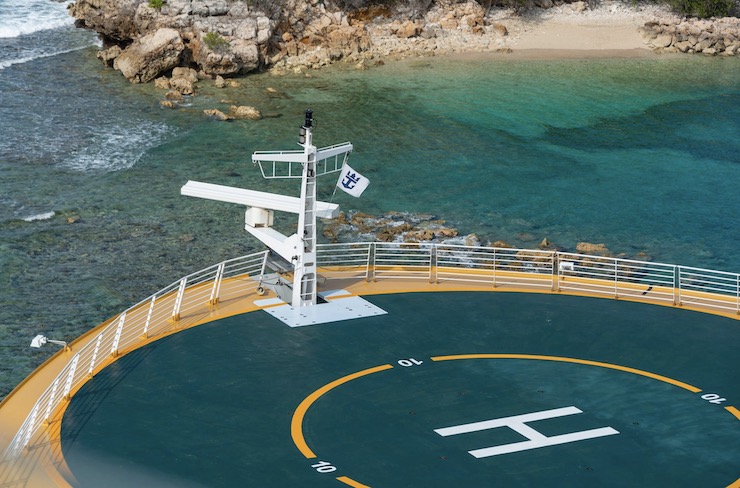
Drones, like any aircraft, need a place to launch and land. While conventional manned airplanes typically use runways and airports, drones, operating in congested urban areas, don’t have that luxury. To carry goods or passengers from a store parking lot, building rooftop, or maybe a client’s backyard, drones will need smaller self-contained spaces geared to rotary-powered aircraft that can take off and land vertically. Hence, the birth of a newfangled structure: Vertiports.
Vertiports already exist in primitive form in store parking lots where retail drones have begun making last mile deliveries to customers for companies like Walmart and Amazon. In addition, hundreds of the nation’s police departments launch drones from their rooftop to pursue criminal suspects or to conduct search and rescue operations.
But a full-fledged vertiport is more than an improvised staging area for drone flights conducted one at a time in response to a specific need. In their fully developed form, vertiports strung together across long distances are meant to allow drones from multiple suppliers to fly continuously, stopping temporarily to recharge their batteries and then setting off on new destinations without returning to an original launch site.
In theory, vertiports could be equipped with air traffic management systems that automatically schedule departure and arrivals and prevent different aircraft from colliding. And the vertiports would also be integrated with local airport systems to ensure the streamlined integration of manned and unmanned aircraft. In other words, vertiports are really the core infrastructure that will allow drone companies to expand their operations and achieve scale nationwide. Simply put, they’re a network of small local and regional airports – but for drones.
While drones have been designed and manufactured – at least in prototype form – for well over a decade, vertiports are only now being created and introduced to support the future of drone flying. Last year, NASA’s Langley Research Center in Hampton, Virginia, and its Ames Research Center in California’s Silicon Valley completed a series of tests at a simulated vertiport facility in anticipation of going live later this year. Remote pilots experimented with routing and rerouting of drone flights as well as emergency landings near the simulated facility to test out NASA’s airspace management, ground control and fleet management systems.
This week, the first FAA-approved public-use vertiport was launched at Allen C. Perkinson Blackstone Army Airfield (known as BKBT), in Blackstone, Virginia, not far from the NASA site. BKBT is an actual dual purpose civilian and military airport that is being adapted as a vertiport to manage a high-density drone airspace and to test the integration of manned and unmanned operations into a single air traffic management system.
Other fledgling U.S. experiments with vertiports – based on a network of ground-based surveillance and obstacle-avoidance systems – are currently underway at the FAA-approved drone test sites in New York and North Carolina. New York’s NUAIR facility is developing the first drone “highway” that allows multiple drones to fly continuously over 50 miles of restricted airspace without the need for remote piloting. Vports, a Canadian company that specializes in the construction of drone infrastructure, has agreed to link parts of the NUAIR corridor to its own large vertiport located in Quebec. Test flights are scheduled for later this year.
Europe’s development of drone vertiport systems is also beginning to surge. For example, the Netherlands’ first drone vertiport became operational last May following a multirotor drone flight test observed by industry and government stakeholders. Vertiport ‘Galileo’ is located on the Future Mobility Park site at Merwehaven in the port of Rotterdam, with a twin vertiport located at the nearby RDM shipyard across the Rhine River. This configuration is billed as a prototype for the development of a larger network of vertiports in Rotterdam, which is the largest seaport in Europe.
Also in May, the city of Zaragoza Spain introduced a vertiport with a surface of 7,500 square meters and a 10-year lease permit. The project is being developed as part of the European Commission-supported project for urban air mobility known as U-ELCOME. The vertiport site is already being used as a training and testing ground for the Hera Drone Hub, which was inaugurated in 2021 with support from Britain-based Altitude Angel, the world’s leading unified traffic manager technology provider and co-developer of Project Skyway, the world’s largest drone corridor.
Europe may enjoy something of an advantage over the United States due to its more open and aggressive support for BVLOS operations without the requirement of remote piloting or visual observation. In addition, Europe is more heavily promoting the harmonization of 5G and LTE communication networks to facilitate the development of integrated air traffic management systems. Finally, a number of major drone companies, including Lilium and Volocopter, both based in Germany, have included the design and development of vertiports as part of their production and sales portfolio.
Still, most of these efforts on both sides of the Atlantic remain largely theoretical. Ground-based infrastructure to support long-distance BVLOS drone flights is being developed sporadically, mainly in support of localized drone hubs. In principle, the industry has acknowledged the need for fully-developed vertiports – as part of integrated air traffic management – to allow the drone industry to achieve scale and fulfill its commercial potential. Veriport networks in several countries, especially in Europe, are scheduled to be fully operational by 2026, but it remains to be seen if enough investment and regulatory support will be forthcoming to achieve this heady goal.
|